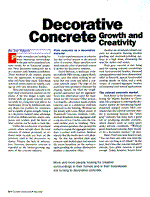 |
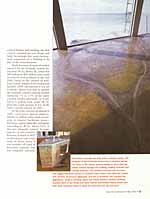 |
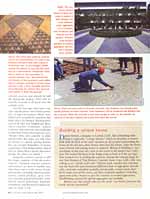 |
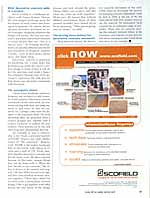 |
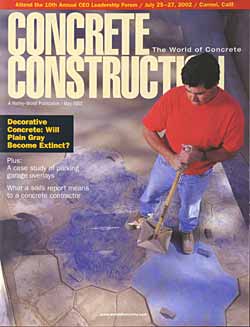
Decorative Concrete
Growth and Creativity
By Joe Nasvik
People nowadays are looking for more interesting surroundings. In the past we've considered concrete mostly for its functional properties. Now decorative contractors see it as a medium with limitless possibilities. Those involved in the creative process have the opportunity to struggle with ideas and leave their mark. Individuals and small artistic teams are rapidly coming up with new decorative finishes.
Basic and functional, concrete is the most used construction material on the planet. If the mix design 'is right, and worker skills are good, concrete serves our needs for a long time with little or no maintenance. It can be molded easily into any shape, has excellent fire resistance, and is capable of great strength. Using it as a decorative material takes advantage of all of its abilities and lets creative companies and workers push the limits of what concrete can be made to look like.
Unlike the production of portland cement, where records show the total amounts of cement produced, no industry-wide records are kept on the products used in the decorative industry. Despite the lack of information, however, decorative concrete is regarded as the fastest-growing segment of the concrete industry.
More and more people looking for creative surroundings in their homes and in their businesses are turning to decorative concrete.
Plain concrete as a decorative material
Color experimentation in concrete has also revived interest in the natural color of concrete. Many specifiers now think that the color of portland cement is perfect for decorative concrete.
David Berkson, a landscape architect with the SWA Group, Laguna Beach, Calif., says that while walking he noticed that tree roots had lifted a concrete sidewalk panel. The edge of the panel had been ground to eliminate the tripping hazard. He liked the roughground appearance and the aggregate. From that observation came the inspiration for the Univision Office project, Los Angeles-decorative bands of plain concrete cast in a pedestrian walkway approach to the building. Working out the details with Lance Boyer, owner of Trademark Concrete, Anaheim, Calif., workers broadcast stone aggregates with a top size of 4 to 5 inches onto the concrete surface prior to finishing. Then, using terrazzo grinders, they ground the surface to expose the aggregate and produce a surface with traction. Berkson reports that the results were very pleasing. He also has specified plain gray concrete with broken glass and ceramic tile pieces broadcast on the surface --again grinding the surface afterward to produce a decorative effect.
Another use of natural-colored concrete for decorative flooring involves grinding and diamond-polishing surfaces to a high shine, eliminating the need for sealers and waxes.
Plain gray concrete is also being used for casting concrete countertops with hard-troweled finishes, diamond cutting patterns and three-dimensional relief in flatwork, special hand-tooled jointing details on slabs, and a wide variety of exposed-aggregate finishes on horizontal and vertical applications.
The colored concrete market
Park Boyer is the director of marketing for Master Builders in Cleveland. His company is entering the decorative market by introducing liquid dispensed integral colors. He's convinced that the colored concrete market is increasing because the "plain gray" industry has done such a good job of producing durable concrete, which doesn't scale or come apart under adverse conditions. "Without good, functional concrete, there wouldn't be a decorative market," he says.
Henry Ford was once heard to say, "You can have any color you want for your car --so long as it's black!" In the past, that's been the concrete industry's attitude, too --plain concrete is good enough. Today, however, buyers favor colored finishes and anything else that creative imaginations can design and build. Increasingly they want the structural component of a building to be part of the ornamentation.
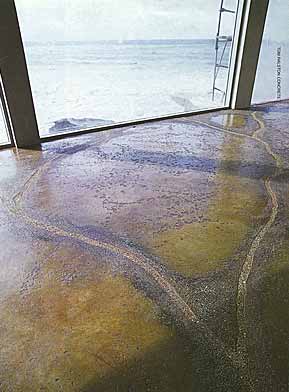 Decorative concrete can help make a project unique. The designer of this California beach house (situated almost too close to the ocean) wanted people to think that the waves washed through the building, eroding concrete and leaving deposits. Tom Ralston Concrete cast the floor with jagged Styrofoam pieces to simulate wide cracks, then filled the cracks with cement, beach-type aggregate, and bits of seashells and exposed the aggregates. Using a retarding agent and turkey basters, workers randomly exposed parts of the living room floor (above) and kitchen island (inset) also. They used chemical stains to make the concrete look old and worn.
Decorative concrete can help make a project unique. The designer of this California beach house (situated almost too close to the ocean) wanted people to think that the waves washed through the building, eroding concrete and leaving deposits. Tom Ralston Concrete cast the floor with jagged Styrofoam pieces to simulate wide cracks, then filled the cracks with cement, beach-type aggregate, and bits of seashells and exposed the aggregates. Using a retarding agent and turkey basters, workers randomly exposed parts of the living room floor (above) and kitchen island (inset) also. They used chemical stains to make the concrete look old and worn.
Mark Justman, director of market research for the Portland Cement Association (PCA), Skokie, Ill., states that 340 million to 400 million cubic yards of concrete were produced in the year 2000, based on the amount of portland cement shipped from production facilities (2001 information is not yet available). Boyer says that at present the integrally colored concrete market represents 1% to 1.5% of the entire concrete market nationally, or 4 million to 6 million cubic yards. He expects this could increase to 6% of the entire concrete market by 2007.
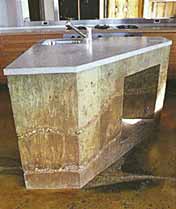
Of the total concrete produced in 2000, contractors placed approximately 22 million cubic yards of concrete in exterior hardscape areas --driveways, patios, sidewalks, and plazas (according to PCA). About 16 % of this was integrally colored. In some regions of the country, however, as much as 30% of all concrete sold is colored. In those areas, if you consider all types of decorative concrete (not just integrally colored), colored concrete may already be half the hardscape market. This will inevitably increase in all areas over the coming years.
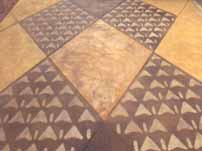 Right: The contractor placed bands of plain concrete In panels of dark Integral colored walkway. Large aggregate (4 to 5 Inches) was broadcast and finished Into the surface. Workers used terrazzo grinders to expose aggregate and provide a traction wear surface. Several years ago, decorative concrete specifications were found primarily on high-end projects where more dollars were available for amenities. But today that's all changed. Building projects of all sizes and budgets get decorative concrete treatments. Andrea Cochran, who owns her own landscape architecture firm in San Francisco, says, "People often view concrete as plain and horrible. But when you add color or texture or special scoring details, they get excited. Regardless of money constraints, I first design artistic appeal into my plans; then I specify decorative finishes the client can afford."
Right: The contractor placed bands of plain concrete In panels of dark Integral colored walkway. Large aggregate (4 to 5 Inches) was broadcast and finished Into the surface. Workers used terrazzo grinders to expose aggregate and provide a traction wear surface. Several years ago, decorative concrete specifications were found primarily on high-end projects where more dollars were available for amenities. But today that's all changed. Building projects of all sizes and budgets get decorative concrete treatments. Andrea Cochran, who owns her own landscape architecture firm in San Francisco, says, "People often view concrete as plain and horrible. But when you add color or texture or special scoring details, they get excited. Regardless of money constraints, I first design artistic appeal into my plans; then I specify decorative finishes the client can afford."
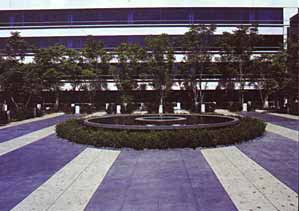
Above: This 8-foot-wide walkway extends around the circumference of a park In the Kierland Commons retail town center in Scottsdale, Ariz. As the designer, EDAW wanted the pattern to look like the markings on a diamondback rattlesnake. Dana Boyer, owner of "the concretist" In Apache Junction, Ariz., first acid-etched and stained all the pavement, used aniline dyes to enhance coloring In certain areas, and then made a steel template and stencil-sandblasted the pattern. She used solvent sealers to finish the process.
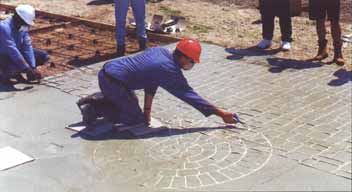
Above: There are many ways to decorate concrete. Here finishers are placing paper stencil patterns on fresh concrete. Color hardeners will be broadcast and finished Into the concrete. When the concrete Is just hard enough to walk on, the stencils are removed to provide a pattern and a joint that looks like mortar.
Integrally colored concrete is still the largest segment of the decorative industry. Stamped concrete patterns and extures are next in market size. After that comes a wide variety of popular finishes, including chemical stains, overlay cement products, spray overlays, stenciled patterned finishes, sandblasted stencil patterning, diamond cut patterns, and decorative sealers/coatings, to name a few.
Building a unique house
Dennis Britton, a designer in Carmel, Calif., likes rehabbing older homes --especially " cottage houses," which he describes as homes built with the floor at the same elevation as the ground's home. In the old days, these homes often had dirt floors. Later the floors were covered with paving stones or concrete. Britton is a vacation home of this type very close to the ocean in the Santa Cruz, Calif. area. He wanted the floor in the living room to look as if the sea regularly washed over it, eroding the concrete. During the concept stage, he met Tom Ralston of Tom Ralston Concrete, Santa Cruz., Calif., who was willing to try "off-the-wall stuff." Ralston made samples first and then
cast the floor. His team broadcast different kinds of aggregates sporadically, randomly embedded seashells, intentionally created cracks that drain water toward the ocean, and then randomly applied a retarding
agent with turkey basters to give the concrete an eroded appearance. Sandblasting exposed the special aggregates and seashells.
Britton says that people who see the work "are blown away by the result and are fascinated!"
What decorative concrete adds to a project
Kevin Crehan is a landscape architect with Nuszer Kopatz, Denver. His firm designs hardscape areas for developers of retail centers and housing developments. He almost always specifies decorative pavement for retail frontages, designing whatever the budget will permit. His firm uses decorative pavement and vertical elements to create themes that say "this is a special area." In housing developments, he specifies different pavements and treatments to designate outdoor "rooms," such as pool decks, picnic areas, and shade areas.
Decorative concrete is important for marketing, too. Crehan states that developers can justify the cost for a creative design in terms of how it will affect the sales pace and create a legacy that ultimately becomes part of the developer's reputation. He adds that his firm always uses decorative treatments with discretion.
The synergistic effect
Clients retain landscape architects, designers, and architects to add creativity to their projects. Decorative concrete contractors, on the other hand, are constantly playing with ideas and using materials in new ways. So does the creativity for a project come from the designer or the contractor? Both. The most interesting ideas are generated when a creative designer gets together with a creative contractor to explore the possibilities. These sessions can be fun, and often long-term relationships develop.
An example of such a relationship is Jim Hyatt, a principal partner of EDAW, Denver, and Mike Miller, owner of "the concretist," Benecia, Calif. EDAW is the largest landscape firm in the world, with offices in 23 cities and a staff of 750. Hyatt regularly specifies decorative concrete and has for many years. He likes concrete because of the many unique things that can be done with it. When his firm decides to use concrete, "the effort is always to be creative and original." He met Miller several years ago, and they have worked on many projects together. "These days, when I'm involved with a particularly creative design, I like to get together with Mike during the idea phase of the design
process and kick around the possibilities. Mike's very creative, and I like what we come up with together," Hyatt says. He knows that without Miller's involvement many of their projects wouldn't have turned out to be as interesting. "Mike gets us going, and we create," he adds.
The driving force behind the decorative concrete movement
Brad Bowman started the decorative concrete movement in the early 1950s when he developed the process for stamping concrete impressions. Until he died in 2000 at the age of 90, his mind played with new, creative ways to use this material., He particularly liked concrete for its unlimited range of possibility, Those who are currently moving this industry forward follow in his footsteps --enjoying the creative process and always keeping an open mind about new ways to use concrete.
